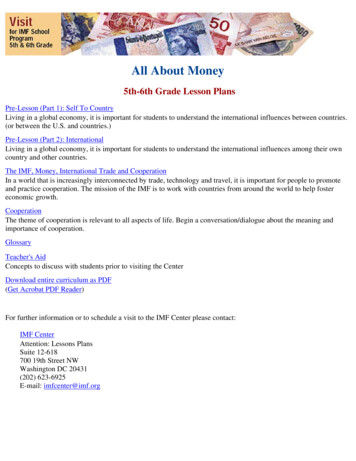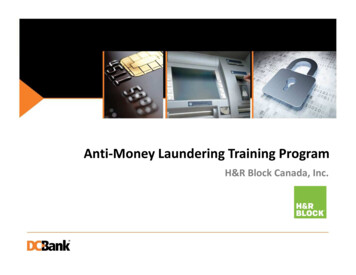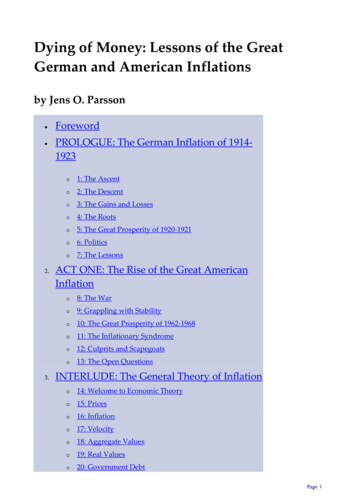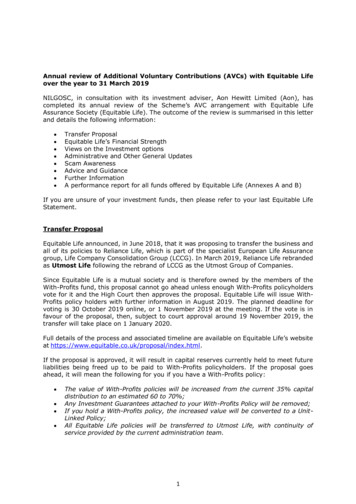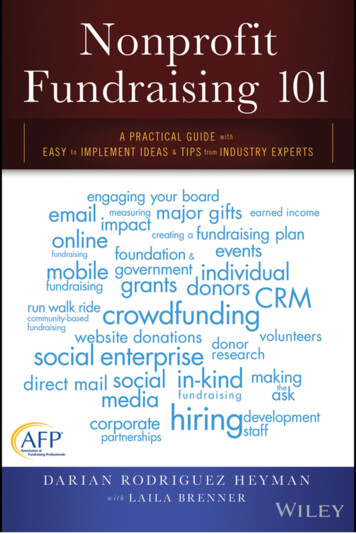
Transcription
Raise more money for your cause!About Nonprofit Fundraising 101Based on expert advice and insights from a variety of respected industryexperts, Nonprofit Fundraising 101 is an essential text for nonprofitprofessionals, volunteers, activists, and social entrepreneurs who want toleverage best practices to promote their cause.Built upon the success of the best-selling Nonprofit Management 101, thiseasy to digest book provides practical, comprehensive guidance fornonprofit fundraising around the globe. With tips and tools, expert advice,and real-world insights from almost fifty industry leaders, this robustresource addresses the entire spectrum of fundraising for nonprofits,including: Planning, hiring, and tracking progress Individual donors, major gifts, events, and direct mail Board and volunteer engagement Foundation and government grants Corporate partnerships Online and email fundraising Social media and mobile crowdfunding Earned income and social enterpriseWritten by and for front line practitioners and geared towards a globalaudience of emerging and established leaders, this field guide offers stepby-step formulas for success. Nonprofit Fundraising 101 features a forewordby fundraising guru and Soul of Money author Lynne Twist, insights fromnotable non-profit professionals such as CNN's Van Jones, and anafterword by Kiva.org Co-Founder & President Premal Shah.This book also provides indispensible ideas and diverse case studiesranging from grassroots efforts to the ALS Ice Bucket Challenge, andadvice for organizations of all sizes and focus. Chapters are brief and easilydigestible, featuring extensive resources for additional learning, concretebest practices, and pitfalls to avoid. Enjoy this must-read manual to learntried and true ways to raise more money for your cause, nonprofit, orcharity and order now!
ContentsAbout the BookxviiAcknowledgmentsxxvForeword: Discovering What It Means to Be a FundraiserLynne Twist, author of The Soul of Money: Reclaiming theWealth of Our Inner ResourcesxxviiPART 1: Planning for Success and Preparing Your Team1Chapter 1Creating a Fundraising PlanInterviewee: Andrea McManus, president of The Development GroupInsets: Dispelling the Overhead Myth; Sample Fundraising Plan3Chapter 2Hiring and Training Development StaffInterviewee: Missy Sherburne, cheif partnerships officer atDonorsChoose.orgInset: Get Your Executive Director to Love Fundraising withBrian Gougherty, director of major gifts at Worldreader13Chapter 3Engaging Your BoardInterviewee: Lisa Hoffman, fundraising and board developmentconsultant25Chapter 4Volunteer FundraisingInterviewee: Simon Tam, director of marketing at OregonEnvironmental CouncilCase Study: APANOxi37
xiiCONTENTSPART 2: Building Your Toolkit and Tracking Progress45Chapter 5Prospecting and Donor ResearchInterviewee: Helen Brown, co-author of Prospect Research forFundraisers: The Essential Handbook and president of theHelen Brown Group47Chapter 6Donor Databases and CRMInterviewees: Suzanne DiBianca, president and co-founder ofSalesforce.com Foundation, and Peggy Duvette, directorof social impact at NetSuite57Chapter 7Measuring Impact: Data, Stories, and OrganizationalDashboardsInterviewee: Stever MacLaughlin, director of analytics at BlackbaudInset: Outputs Versus OutcomesCase Study: charity: water with Kaitlyn Jankowski, supporterexperience manager at charity: waterPART 3: Individual Donors6577Chapter 8Grassroots Fundraising: Building Your Donor PyramidInterviewee: Kim Klein, author of Fundraising for Social Changeand principal of Klein & Roth ConsultingInset: Don’t Be Afraid to Dream Big79Chapter 9Major Donors: Building Relationships, Making the Ask,and StewardshipInterviewee: Kay Sprinkel Grace, author of Beyond Fundraisingand fundraising consultantInset: Tracking Major Donors in Databases87
ContentsxiiiChapter 10Direct Mail: The Ins and OutsInterviewee: Mal Warwick, author of Revolution in the Mailboxand founder and chairman of Mal Warwick Donordigital99Chapter 11Year-End, Annual Appeals, and Membership Campaigns 107Interviewee: Farra Trompeter, vice president at Big Duck andvice chair of the board at NTENInset: Sample Year-End Campaign CalendarChapter 12Event-Based Fundraising117Interviewees: Tracy Kosolcharoen, marketing manager atEventbrite, Daniel Lurie, CEO and founder of Tipping PointCommunity, and Jen Pitts, managing director of communications,events, and development at Tipping Point CommunityInset: Van Jones’ Live Ask Recipe with Van Jones, CNNcorrespondent and president and co-founder of Dream CorpsChapter 13Runs, Walks, and Rides: Community-Based FundraisingInterviewee: Jeff Shuck, founder and CEO of PlentyCase Study: Kyra Millich, volunteer fundraiser133Chapter 14Fundraising Across the Generations: Millennials, BabyBoomers, and MoreInterviewees: Alia McKee, principal of Sea Change Strategies,and Derrick Feldmann, president and founder of AchieveInset: The Generations: What Fundraisers Need to Know143
xivCONTENTSPART 4: Online Fundraising153Chapter 15Maximizing Website DonationsInterviewee: Caryn Stein, vice president of communications andcontent at Network for Good, and editor of The NonprofitMarketing blogCase Study: Mercy House, by CommitChange155Chapter 16Fundraising with Email165Interviewee: Kivi Leroux Miller, author of The Nonprofit MarketingGuide: High-Impact, Low-Cost Ways to Build Support for Your GoodCause and president of NonprofitMarketingGuide.comInset: Email Cheat Sheet, by CommitChangeChapter 17Social Media and Crowdfunding for Your Cause175Interviewees: Beth Kanter, author of The Networked Nonprofit andblogger, and John Haydon, author of Facebook Marketing forDummies and founder of Inbound ZombieInset: P.O.S.T. to Social MediaSocial Media Case Study: The ALS Ice Bucket Challenge withLance Slaughter, chief chapter relations and development officerat the ALS AssociationAppendixPractical Tips for Key Social Media PlatformsCrowdfunding Case Study: RE-volv, with Andreas Karelas,founder and executive director at REV-volv189Chapter 18Mobile Fundraising195Interviewees: Heather Mansfield, author of Mobile for Good: A How-ToFundraising Guide for Nonprofits and principal blogger at NonprofitTech for Good, and Tanya Urschel, nonprofit vertical manager at PayPalInsets: Planning for Success: The Mobile Matrix by Sparrow: Mobilefor All; Text-to-Give
ContentsPART 5: Foundationsxv205Chapter 19Research, Getting in the Door, and Securingan Invitation to ApplyInterviewees: Tori O’Neal McElrath, author of Winning GrantsStep by Step and founder of O’Neal Consulting Services, andLeeanne G-Bowley, manager of capacity and leadershipdevelopment at Foundation Center and artistic and executivedirector at In-Sight Dance CompanyInsets: The Different Kinds of Foundations; Types of Grants207Chapter 20Government Grants221Interviewee: Joshua Sheridan Fouts, executive director at BioneersInset: Where to Find Government GrantsChapter 21Writing a Winning LOI and Proposal227Interviewees: Susan Fox, co-author of Grant Proposal Makeover:Transform Your Request From No to Yes and fundraising consultant,and Jane C. Geever, author of The Foundation Center’s Guide toProposal Writing and founder of J.C. GeeverChapter 22Tracking Progress and Reporting BackInterviewee: Beverly Browning, author of Grant Writing forDummies and vice president of grant writing services at eCivisInset: Logic ModelsPART 6: Corporate Support235243Chapter 23SponsorshipsInterviewee: Maureen Carlson, president of GoodScoutInset: Sponsorship Proposal Template245
xviCONTENTSChapter 24Cause Marketing PartnershipsInterviewees: David Hessekiel, co-author of Good Works andpresident of Cause Marketing Forum, and Joe Waters, authorof Cause Marketing for Dummies and founder of Selfish GivingInset: Cause Marketing Proposal Tips255Chapter 25In-Kind Fundraising and Media SponsorshipInterviewee: Gayle Samuelson Carpentier, chief businessdevelopment officer at TechSoup GlobalPART 7: Unlocking Social Enterprise265273Chapter 26Earned Income StrategiesGuest Contributor: Rick Aubry, professor of social enterprise atTulane University and founder of Rubicon ProgramsSocial Enterprise Case Study: Grow Dat275Afterword: Finding Your PathPremal Shah, president and co-founder of Kiva.org287Closing ThoughtsBook PartnersAbout the AuthorsIndex291295317319
12ChapterEvent-BasedFundraising“A mind that is stretched by a new experience can never goback to its old dimensions.”—Oliver Wendell Holmes, Jr.IntroductionIn today’s digital age, much of our fundraising and relationship-buildinghappens through technology. It is becoming less common for fundraisersto have personal interactions with donors, but these are still critical whenraising funds and developing connections. Events are an important way toengage with donors and create an experience that not only brings awarenessto your cause, but also inspires a sense of community among supporters andgenerates much-needed funds. They’re also an important way to engage withMillennials and younger audiences. Eventbrite found that over 75 percentof the Millennials they surveyed would rather spend money on a desirableexperience—such as an event—versus simply donating, and over two-thirdssaid events make them feel more connected to a cause. It’s crucial that yournonprofit effectively engage your next generation of donors, and events areone key to doing this.117
118NONPROFIT FUNDRAISING 101Events require a significant amount of time and effort and aren’t often anorganization’s primary source of funding. However, when done right the benefitsyou reap with a successful event far outweigh the resources you invest in it.Events can play a key part in cultivation and stewardship strategies, makingcritical differences in your efforts with major donors, foundations, and importantallies like partners and board members. Live events will help you reap additionaldonations from key supporters and inspire new ones to join you. They’re keymarketing opportunities and great ways to get your cause and story in front ofmore people, and events provide a focal point for people to rally to your cause.There are endless types of events, but all of them should reflect yourorganization and fit within your fundraising strategy. If your goal is toidentify and cultivate a small group of high net worth donors, think abouthaving a small event at the home of a board member or major donor. Ifyou’re a small, grassroots organization fighting economic injustice, youprobably don’t want to throw an expensive and fancy gala. Whatever yourstrategy, events provide an opportunity to inspire people in ways that otherforms of communication simply cannot.To learn more about maximizing the fundraising potential of nonprofitevents, I sat down with Tracy Kosolcharoen, marketing manager andnonprofit lead at Eventbrite, and Daniel Lurie and Jen Pitts at TippingPoint Community. They shared ten great practical insights and tips to helpyou bring more money in the door.Critical Skills and Competencies1. Identify Specific GoalsWhat is the primary goal of your event—raising money, identifying newdonors, spreading awareness, or promoting your cause? According to Lurieand Pitts, the key to success is a clear purpose that drives and focusesall of your efforts. Once you’ve identified your primary goal, you need toset additional, specific event goals, like number of attendees, tickets sold,money raised, and so forth. Take the time to think through the impact ofyour event. What will you accomplish, and why are you doing this? Youneed to be able to clearly communicate the purpose and impact of yourevent in marketing materials and to the supporters who join you in person.Think about your key stakeholders—donors, board, volunteers, staff,vendors, and more—and ask yourself: What do we want the experience to
Event-Based Fundraising119be like for them? Remember, your event begins long before the actual day; itbegins the moment you start talking to people about it.2. Create a Calendar and a BudgetCreate a calendar and work backward from your event date. List allnecessary tasks (such as creating marketing materials, securing volunteers,selling tickets, securing sponsors and auction items, solidifying logistics likevenue and catering) and assign deadlines and people responsible for eachitem. Create a conservative budget that estimates the revenue you expect,plus all related expenses. Use past events as a baseline if possible, justifyingany increases in expectations, and keeping those to 10 to 25 percent,unless there’s a significant change in format. If this is your first event, thinkthrough how many tickets, tables, and sponsorships you can realisticallysell. And be conservative when it comes to your expenses as well, especiallyaround items like beer and wine that you hope to have donated.Once you have a reasonable budget, including both projected revenue andexpenses, compare those two numbers. If you don’t project raising at leasttwice as much as you spend, then don’t call it a fundraiser. That’s not to sayyou shouldn’t do the event, but think of it as a “friend raiser” or networkingevent to manage expectations. Keep people accountable to the budget andyour deadlines by holding regular meetings to assess your progress.3. Recruit Key PeopleYour next step is mobilizing the human resources needed to succeed. Thesepeople, including staff, board, volunteers, and key supporters, will be criticalto maximizing your fundraising results. Recruit an event committee atleast six months out, so that you have a team of people helping to focusand drive your efforts. Key duties and roles include recruiting and managingvolunteers, coordinating logistics, promoting ticket sales, securing auctionitems, and most importantly, enlisting speakers, performers, in-kind andmedia partners, and sponsors and table captains. If you have enough peopleon your committee, divide their roles and assign responsibility for these.As detailed in Chapters 3 and 4, when engaging your board or volunteersin fundraising, the key to success is making it as easy as possible for them tosupport you. Again, think “low touch, high value” and create toolkits withsample emails and social media posts and images to facilitate outreach.This is helpful to drive ticket sales down the road, and to securing sponsors,
120NONPROFIT FUNDRAISING 101table captains, and partners when you’re starting out. And as we discuss inChapter 17, Social Media and Crowdfunding, “seeding the tip jar” helpsdrive support, so tap this inner circle of supporters to secure initial ticketsales, event hosts, and sponsors before engaging the public.Ensure expectations are clearly communicated to everyone you recruit, andthat you leverage them strategically so they feel engaged and see the impactof their contributions.4. Secure SponsorsIf your event strategy includes securing corporate, individual, or foundationsponsorships, begin outreach at least six months in advance. Securingsponsors requires time and cultivation, and many institutions need monthsto budget for this support.Think through what you are asking of sponsors, and what you are offeringin return. Having a solid sponsorship package that outlines the variouslevels and associated benefits will be key in driving results. Even if you’resoliciting people and foundations, the most effective event sponsorshipproposals typically follow the corporate framework outlined in Chapter23 and include an option for table captains, also known as event hosts.Table captains typically buy eight to ten tickets and receive recognition atthe program, plus entry to a VIP reception beforehand if you include that inyour agenda. Often, their guests will pay for their tickets anyway, resultingin twice the revenue. And as discussed in Chapter 25, pursue in-kind andmedia sponsorships using your corporate proposal as a template, and thenmake a few edits to customize it for this audience.When reaching out to sponsorship prospects, start with past event sponsorsand your biggest supporters. Thank them for their patronage and remindthem of the impact they’ve made possible before inviting additional support.For example, with the 100 million Tipping Point Community raised overthe past ten years, they’ve impacted nearly 500,000 people living in poverty.In addition to these big numbers, they often personalize impact by sharingindividual stories of those who’ve benefited from their work.Finally, remember that providing sponsors with a great experience is key tosecuring their support in the future. Nurture these valuable relationships,and make sure to fulfill and over-deliver on any promises you make. Andtake the time to figure out what’s most important to these key partners
Event-Based Fundraising121so you can be sure to meet their needs. For example, ask sponsors whatinformation they’d like to know about your audience, and then integraterelevant questions into the registration process or follow-up surveys.5. Build a Strong Event PageAll-in-one event registration platforms like Eventbrite allow you to easilybuild an integrated event page to sell tickets and promote your event. Yourgoal with the event page is to maximize your conversion rate, meaning thepercentage of people who visit the page who actually sign up to attend.The first step to improving your event page’s conversion rate is leveragingyour prime content areas, including the upper-right-hand corner of thepage, the middle of the page “above the fold,” and in your navigationbar. “Above the fold” is an old newspaper term, meaning people see itwithout needing to scroll down or flip the page. These key areas are whereyou want to share the what, where, when, and how of your event, and besure to focus on only one call to action. Ideally, create a button that says“Sign up now,” “Order Tickets,” or “Register.”Once people click on the button, offer group registration options andprovide people with opportunities to donate if they are unable to attend.Use a tool like Eventbrite to ensure your event page is compatible withmobile devices, able to be integrated with your database or CRM, and that itenables people to easily share the event information through email and socialmedia. It’s critical that you use a platform that prompts people to invitetheir friends to attend immediately after registering. Just as with onlinefundraising, making it easy for people to invite their social networks to followtheir lead after they donate or sign up drives huge results; in fact, Eventbritediscovered that 67 percent of event shares happen after registration and thatevery Facebook share is worth 4 in ticket sales. Social media shares can alsodrive “FOMO,” or fear of missing out, since people considering attendingcan see which of their friends registered and be motivated to do the same.One final note on the registration portion of your event page: keep it simpleand ask only for necessary information. Eventbrite’s research establisheda clear, direct correlation: the more fields in your registration form, thelower your conversion rate. Part of this is due to load time—the AberdeenGroup found that a one-second delay decreases conversion rates by 7 to10 percent. You can always collect more details later, so focus exclusivelyon securing the information you need to register people. If you really want
122NONPROFIT FUNDRAISING 101to know what music people want, secure input on the direction of theevent, or figure out which conference sessions people plan to attend, send afollow-up email after people sign up.6. Promote Your EventNow that you have your team and plan in place, as well as your eventregistration page, it’s time to spread the word. Start by leveraging yourexisting networks and outlets, including social media, public relations,your newsletter, mailing list, etc. Eventbrite found that email is themost effective way to recruit event attendees, followed by social media,particularly Facebook and Twitter. Coordinate and plan all your outreachin an editorial calendar, as detailed in Chapter 17.Remember that you’re not in this alone: engage your events committee andvolunteers, possibly including a social media marketing committee, alsooutlined in that chapter. Recruit any event speakers or VIPs to this team,reminding them the commitment is limited to just five minutes a week andproviding outreach toolkits to make emailing and posting as easy as cut andpaste. Ideally, give each person or partner on your event committee a uniquetracking link or URL so you can easily gauge which team members provedmost valuable as you plan future events.Collectively, all this outreach drives excitement and momentum. This iscrucial since typically people need to hear about an event six times beforethey sign up. Beyond the peer-to-peer and organizational marketing, don’tforget that media sponsors are another great way to generate tremendousexposure, as detailed in Chapter 25. Finally, if you have a Google Grant,leverage AdWords to drive traffic to your event page, and add keywordsthere to maximize search engine rankings.7. Understand the Ticketing LifecycleAccording to Eventbrite, most nonprofits launch ticket sales six to eight weeksout, which they’ve identified as a best practice. Kosolcharoen recommendsyou provide a 10 to 20 percent early bird discount for the first two weeks todrive initial registrations, since 40 percent of events sell less than half their ticketsuntil the week of the event. This results in tremendous stress; plus it complicatesplanning and logistics, such as catering orders. Anything you can do to combatpeople postponing their registrations will help on many levels, but be sure thatyou’re covering your costs before offering any discounts.
Event-Based Fundraising123Use social media to build momentum and encourage early signups withthings like hashtags, which allow you to track and encourage conversationsaround your event, and which can result in your event trending on socialmedia. Use free tools like Twubs or Hashtag.org to look these up and ensureno one else is using them, or simply search on Twitter itself. We talked aboutFOMO earlier; Eventbrite found that 80 percent of Millennials experienceand are driven by this phenomenon. To capitalize on it, offer incentivesthrough contests promoting your hashtag, price discounts, or reservedseating to drive ticket sales. Invite people to tweet about your event inexchange for a chance to win tickets, or hold a contest where the person withthe most retweets or shares gets to meet a VIP or keynote speaker.8. Create an AgendaWell before event day, it’s very helpful to map out a detailed timeline,or “Q2Q,” for your program, including time for both preparation andbreakdown. Map out a realistic agenda and leave in cushions, because thingsalmost always run late. Here’s a typical sample agenda for a donor event,including a few tips for each component:t Welcoming Reception (cocktails, appetizers, and time to mingle;Jazz or other light background music; if you have a VIP Reception,it typically happens here in a private room)t Food Service (dinner or lunch with sit-down service for moreformal events; it’s ideal to wait until plates are cleared before startingthe program to avoid background noise)t Welcoming Remarks (two-to-three-minute welcome from a keyboard member, MC, or sponsor; this can also be accomplished via ashort video)t Client Testimonial/Mission Moment (a client shares the impact ofyour work on his or her life, personalizing your work; can also be abrief partner report speaking to your effectiveness and the impactof a compelling program/project. Either way, this can also beaccomplished via a short video)t Live Auction (use an experienced auctioneer if possible; secureminimum bids ahead of time to ensure responses and kick-startmomentum; packages revolving around unique prizes that moneycan’t buy, like lunch with a celebrity, are ideal)t Presentation from Executive Director (outline the historyand impact of the organization; share the event’s purpose andfundraising goal and the overall impact it will make possible)
124NONPROFIT FUNDRAISING 101t The Ask (pass around donation envelopes and have volunteerspoised with mobile devices to collect donations—see insert belowfor detailed process and tips)t Announce the Results (thank the audience and let them know howmuch was raised and what these funds will allow you to accomplish)This may sound like a lot to get through, but in fact, you’re best off keepingyour program as short as possible. After years of experimentation, TippingPoint Community recommends you keep the spoken portion of yourprogram to 15 to 45 minutes. If you’re hosting a small, casual event—especially one where people remain standing—keep it to no more than 15 to20 minutes. If it’s a larger, more formal event like a gala or luncheon, keepyour presentation to less than 45 minutes. If you talk for too long, you’lllose people’s attention. Give your speakers and presenters clear guidanceand provide them with key messages and talking points in advance. Anddefinitely take the time to rehearse with them before the big day.9. Maximize Your AskThere are lots of ways to raise funds on site at your event, including silent andlive auctions, “fund a need”s, and of course, making an ask. If one of yourmain event goals is fundraising, then—unless there’s a compelling reason—it’scrucial you explicitly and directly invite people to donate and support yourgood work. There are different approaches for doing this, including the onedetailed below by one of my personal heroes, Van Jones. Not surprisingly,after raising more than 100 million, in large part via their annual benefit,Tipping Point Community has dialed in their unique recipe for success.As with many nonprofits, the CEO and founder, Daniel Lurie, hastraditionally been the spokesperson who makes the big fundraising ask.Tipping Point creates an exciting, dynamic environment that evokes peerpressure and friendly competition to maximize giving. After sharing theoverall work of the organization to date, and the impact its current campaignwill unlock, he tells the audience that the group’s board underwrites alloperating expenses—so every dollar raised goes directly to the cause—and,when possible, shares a matching or challenge grant to inspire giving.In partnership with an auctioneer, Lurie then invites attendees to stretchthemselves as much as they can, with gifts ranging from 25 to more than 1million. Over the years, Tipping Point has experimented with using glow sticksas bidding paddles, asking everyone to bid at once using event technology
125Event-Based Fundraisinglike LUMI, and visibly opting in at various pledge levels. Of course, there aredonation envelopes on the tables for people to complete, as well as volunteerspoised to assist donors with giving. Pitts cautions double-checking your cellularand Wi-Fi connection before experimenting with various technologies andmobile phone–based giving transactions. Finally, just as with auction items,Lurie advises securing some gifts in advance if you plan to invite support atvarious levels, which helps inspire others to follow suit and match giving.Van Jones’ Live Ask RecipeIn all my years of fundraising and running in nonprofit circles,I’ve been to lots of galas and fundraising events. Hands down,I’ve never seen anyone better at making an ask at a live eventthan Van Jones, CNN correspondent and president and co-founderof Dream Corps. I sat down with him to learn a few of his secrets,and he graciously shared his formula for unlocking support.Establish credibility. Speak to your past impact and thestrengths as an organization. Focus on your accolades andaccomplishments, versus the needs or challenges of yourorganization. Frame your work and progress as powerfullyas possible; remember that people want to be part of awinning team, not bail out a sinking ship. It’s also helpfulto share a quick story to put a face to your work; perhaps youtalk about Martin, the 15-year-old who dropped out of school,but whom you helped to get back on track, and who is now asuccessful college student.Humanize your work. Notwithstanding the last comment,it’s still important to authentically share the passion anddedication needed to drive impact. Have one of your staffmembers share the obstacles you’ve overcome along the way,including those he or she faced in their personal role. Jonesfinds this often to be even more effective than talking about thepeople in need, since your audience can identify with them aspeers, and they believe in and want to support their good work.As Jones says, “It’s getting people to think about, ‘How canI help this person, who’s doing something every day that’shard and that I believe in, but the fact is, I’m not doing itmyself? Look at the sacrifice this person is making; their time,their life, their energy. What can I do to help them be moreeffective?’ These are your good, hard-working peers who needyou to chip in.” Instead of merely sharing the same pitch as(continued)
126NONPROFIT FUNDRAISING 101(continued)every other organization, with an exclusive focus on the need,the numbers, and maybe some anecdotes, don’t be afraid topull the curtain back on how difficult—and even scary—thework can be and what keeps you going. Be vulnerable andshare your emotional roller coaster, and let the audience knowhow much is riding on the event as you head into the next day,the next week, and the next month. Help attendees realizethat what they do in the next few moments is going toreally make a difference for the people you serve, andalso on your staff’s ability to help them.Communicate the need. Now that people understand thehuman impact of your work on both staff and clients, it’s timeto share the event goal and help your audience understandthe increased impact their support will make possible. Be clearabout what you’re raising money for and exactly how it willmake a difference. Communicate a specific overall dollar amoun
experts, Nonprofit Fundraising 101 is an essential text for nonprofit professionals, volunteers, activists, and social entrepreneurs who want to leverage best practices to promote their cause. Built upon the success of the best-selling Nonprofit Management 101, this easy to digest book provides practical, comprehensive guidance for







